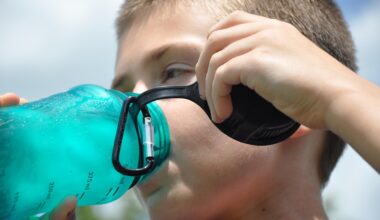Kettlebell Exercises That Enhance Mobility and Stability
Kettlebell training has surged in popularity due to its versatility in improving strength, endurance, and overall fitness. One of the most beneficial aspects of kettlebell training is the ability to enhance mobility and stability through various exercises. Mobility drills specifically target the range of motion in joints, whether in the shoulders, hips, or spine. Performing kettlebell exercises consistently can help prevent injuries stemming from tight muscles and lack of flexibility, which many people suffer from. Importantly, this training method not only focuses on enhancing strength but also on promoting fluid movement patterns. As a result, incorporating kettlebell mobility drills into your workout routine will serve multiple purposes. You can improve your athletic performance or simply enjoy everyday activities with greater ease. As kettlebell exercises often engage multiple muscle groups simultaneously, they foster holistic body development and enhance postural control. Therefore, whether you are a beginner or an advanced athlete, kettlebell mobility drills can benefit you significantly. Moreover, these exercises can be efficiently integrated into different training regimens, providing options that cater to individual fitness goals and needs, making them a perfect addition to any workout plan.
Incorporating kettlebell mobility drills into your training can yield profound benefits. The first drill you might consider is the kettlebell windmill. This exercise not only enhances hip and thoracic spine mobility but also challenges your core stability significantly. Begin by holding a kettlebell overhead with one arm while standing with the opposite foot slightly angled outward. Lean at the hip while maintaining a straight line from the kettlebell to your feet. Keeping your eyes on the kettlebell will help maintain balance while engaging your core and stretching on the opposite side. Practicing this movement regularly works wonders at increasing the range of motion while also reinforcing your ability to stabilize the load overhead. Another valuable mobility drill is the kettlebell halo which revolves your arms around the head while grasping the kettlebell. This dynamic movement promotes shoulder flexibility and mobility while stabilizing the trunk. It’s essential to focus on drawing circles close to your head. The kettlebell is used as a tool to enhance proprioception and stability at the same time, making it a worthwhile inclusion in any mobility training program.
Another effective kettlebell mobility exercise worth mentioning is the goblet squat. The goblet squat seamlessly integrates both stability and mobility, allowing you to maintain proper squat mechanics while enhancing your hip, knee, and ankle mobility. To perform it correctly, hold a kettlebell close to your chest while standing with your feet shoulder-width apart. As you squat down, push your knees outward while keeping your chest up. This positioning encourages an optimal squat depth and facilitates balanced weight distribution. Engaging your core during the movement offers additional support to your lower back, protecting you from injury. Aim to perform several sets of goblet squats, leveraging the kettlebell’s weight to challenge your mobility while ultimately progressing to deeper squats over time. Additionally, it can also serve as a warm-up before heavier lifts, preparing your muscles and joints for more strenuous activity. As your proficiency improves, you can incorporate variations such as the pause squat or the tempo squat, increasing the intensity and making the most of your kettlebell training program, leading to better overall performance.
Kettlebell Split Squats for Enhanced Mobility
Kettlebell split squats are another amazing drill that combines unilateral strength training with enhanced hip mobility. Unilateral exercises like split squats focus on one leg at a time, helping identify strength imbalances while increasing functional mobility. To perform a kettlebell split squat, begin by standing in a staggered stance, one foot forward, and the other foot back. Hold a kettlebell in the opposite hand of your front leg. As you lower your back knee towards the ground, ensure that your front knee stays stacked over your ankle, activating your hip flexors and quads. This movement works the glutes and promotes balance and stability, challenging your core as it demands focus on proper alignment. Aim to perform sets on both sides to enhance mobility further and promote even muscle development. By integrating kettlebell split squats into your routine, you’re not only enhancing mobility but also training your body to function better in everyday movements, which is essential for athletes and casual exercisers alike.
Furthermore, the kettlebell lunge is another drill that significantly improves lower body mobility and overall stability. To perform the kettlebell lunge, grab the kettlebell with both hands and hold it at your chest or let it hang at your side. Step forward into a lunge position, allowing both knees to bend at 90 degrees. This exercise enhances your hip and ankle mobility while promoting stability through the core. Ensure to keep your torso upright throughout the lunge to effectively engage your stabilizing muscles. When transitioning between lunges, maintain control over the kettlebell by keeping it close to your body to minimize injury risks. As you become comfortable with standard lunges, experiment with lateral lunges to further diversify your movement patterns and target different muscle groups. Practicing these various lunge variations consistently will inevitably lead to improved mobility, better athletic performance, and ultimately a more functional body capable of handling various physical tasks in daily life, which is essential for everyone, regardless of their fitness experience.
The Importance of Recovery
Recovery is an integral part of any training regimen, especially when it involves intense mobility drills like those with kettlebells. Mobility work can cause temporary muscle soreness, so prioritizing recovery techniques is vital for long-term benefits. Incorporating active recovery sessions, adequate hydration, and proper nutrition will promote muscle repair and reduce the chance of injury. Consider integrating dynamic stretching and foam rolling into your routine to enhance recovery. Another option includes using the kettlebell itself for recovery; exercises performed with light weights provide therapeutic benefits for tired muscles. Gentle movements such as kettlebell swings or light overhead presses can maintain mobility while allowing relief for any tension built during more intensive workouts. Listening to your body is crucial; should you feel fatigued or sore, allowing sufficient rest or active recovery days will minimize burnout. Engaging in restorative practices such as yoga or breathing exercises can effectively complement your kettlebell training, boosting flexibility, core strength, and over time enhancing mobility. Ultimately, balancing your kettlebell training with recovery will improve your performance and allow for holistic growth, helping you reach your desired fitness goals effectively.
In conclusion, kettlebell mobility drills serve to enhance mobility and stability, catering to all types of fitness enthusiasts. The dynamic ways to incorporate kettlebells into your mobility routine can yield tremendous benefits, improving your performance across other exercises and activities. Integrating exercises such as the kettlebell windmill, goblet squat, split squat, and lunges promotes not only muscle strength but also increases flexibility and positional awareness. Furthermore, allowing appropriate time for recovery and engaging in proper techniques will foster a healthier body overall. Whether you want to pursue athletic goals or maintain an active lifestyle, the tools provided through kettlebell training create an opportunity for anyone to achieve a more mobile and stable body. Thus, consider adding kettlebell mobility drills into your regimen today. Challenge yourself and benefit from a stronger, more integrated training experience that leads to lasting results. Join the ranks of those who take advantage of this practical and powerful training tool; explore the vast possibilities that kettlebell movements offer for enhancing mobility in every aspect of your life.
This exploration of kettlebell exercises for mobility emphasizes their critical role in fitness. Engaging in kettlebell training not only strengthens your core but also cultivates enhanced body awareness. Therefore, keep your movements intentional and controlled to fully absorb the benefits kettlebells can offer. The progression from basic exercises to more complex mobility drills can be gradual, allowing your body to adapt safely. With time and consistency, you’ll notice marked improvements in your functional movement capabilities, bringing more ease and fluidity to daily activities. The combination of strength-building and mobility-enhancing attributes makes kettlebell training an invaluable tool. As more fitness enthusiasts and athletes seek to optimize their performance, kettlebell exercises stand out as a prime choice for fostering overall strength and agility. Stay motivated and curious about how such a simple piece of equipment can contribute greatly to your fitness journey. Embrace the challenges that kettlebell mobility drills provide and capitalize on the lasting positive impacts they have on your body, helping you maintain optimal health, and stability throughout life’s physical demands.


